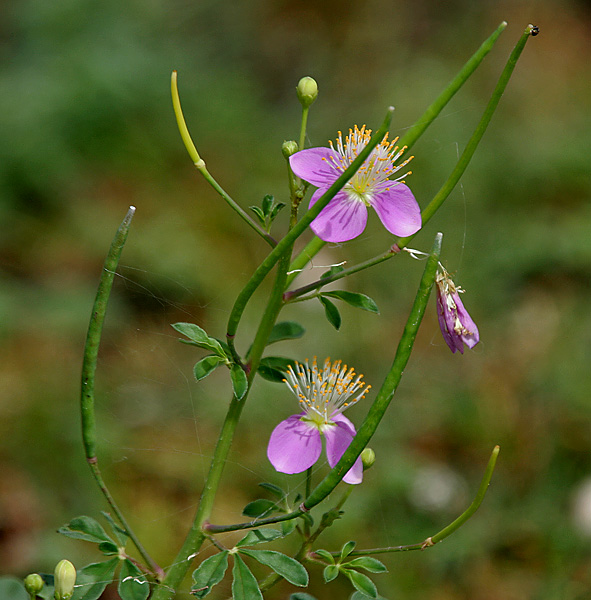|
Cleome Rutidosperma
''Cleome rutidosperma'', commonly known as fringed spider flower or purple cleome, is a species of flowering plant in the genus ''Cleome'' of the family ''Cleomaceae The Cleomaceae are a small family of flowering plants in the order Brassicales, comprising about 300 species in 10 genera, or about 150 species in 17 genera.Cleomaceae, Zhang Mingli (张明理)1; Gordon C. Tucker2, Harvard.edu/ref> These genera ...'', native to tropical Africa. This species is an invasive weed throughout most lowland wet tropical areas of Asia and Australia. It is a very common weed of lawns. Description Fringed spider flower is an erect, branched, annual herb, growing up to 15–100 cm tall. The plant has angular stems and trifoliolate leaves on stalk. Each leaflet is somewhat diamond-shaped. The flowers are very small (about 15 mm across) with upward pointing purple petals and protruding stamens and pistil. Pollens are elongated, approximately 29 microns in size. Image:Cleome rutid ... [...More Info...] [...Related Items...] OR: [Wikipedia] [Google] [Baidu] |
Cleome
''Cleome'' is a genus of flowering plants in the family Cleomaceae, commonly known as spider flowers, spider plants, spider weeds, or bee plants. Previously, it had been placed in the family Capparaceae, until DNA studies found the Cleomaceae genera to be more closely related to the Brassicaceae than the Capparaceae. Cleome and clammyweed, (''Polanisia dodecandra'') can sometimes be confused. The simplest way to differentiate the two is to compare the seedpods which project out or down on cleome and up on clammyweed. The genus ''sensu stricto'' includes about 170 species of herbaceous annual or perennial plants and shrubs.Huxley, A., ed. (1992). ''New RHS Dictionary of Gardening'' 1: 652-653. Macmillan. . The genus has a subcosmopolitan distribution throughout the tropical and warm temperate regions of the world. However, a recent DNA study failed to separate ''Cleome'', ''Podandrogyne'', and '' Polanisia'' from each other, so some taxonomists have abandoned the last two of the ... [...More Info...] [...Related Items...] OR: [Wikipedia] [Google] [Baidu] |
Cleomaceae
The Cleomaceae are a small family of flowering plants in the order Brassicales, comprising about 300 species in 10 genera, or about 150 species in 17 genera.Cleomaceae, Zhang Mingli (张明理)1; Gordon C. Tucker2, Harvard.edu/ref> These genera were previously included in the family Capparaceae, but were raised to a distinct family when DNA evidence suggested the genera included in it are more closely related to the Brassicaceae than they are to the Capparaceae. The APG II system allows for Cleomaceae to be included in Brassicaceae.Stevens, P. F. (2001 onwards) Angiosperm Phylogeny WebsiteBrassicales Taxonomy In 1994, a group of scientists including Walter Stephen Judd suggested to merge the Capparaceae (which at that time included the Cleomaceae) with the Brassicaceae. Early DNA-analysis showed that the Capparaceae - as defined at that moment - were paraphyletic, and others suggested to assign the genera closest to the Brassicaceae to the Cleomaceae. The Cleomaceae and Brassicac ... [...More Info...] [...Related Items...] OR: [Wikipedia] [Google] [Baidu] |
Flora Of Africa
Flora is all the plant life present in a particular region or time, generally the naturally occurring (indigenous) native plants. Sometimes bacteria and fungi are also referred to as flora, as in the terms '' gut flora'' or '' skin flora''. Etymology The word "flora" comes from the Latin name of Flora, the goddess of plants, flowers, and fertility in Roman mythology. The technical term "flora" is then derived from a metonymy of this goddess at the end of the sixteenth century. It was first used in poetry to denote the natural vegetation of an area, but soon also assumed the meaning of a work cataloguing such vegetation. Moreover, "Flora" was used to refer to the flowers of an artificial garden in the seventeenth century. The distinction between vegetation (the general appearance of a community) and flora (the taxonomic composition of a community) was first made by Jules Thurmann (1849). Prior to this, the two terms were used indiscriminately.Thurmann, J. (1849). ''Essai de ... [...More Info...] [...Related Items...] OR: [Wikipedia] [Google] [Baidu] |


